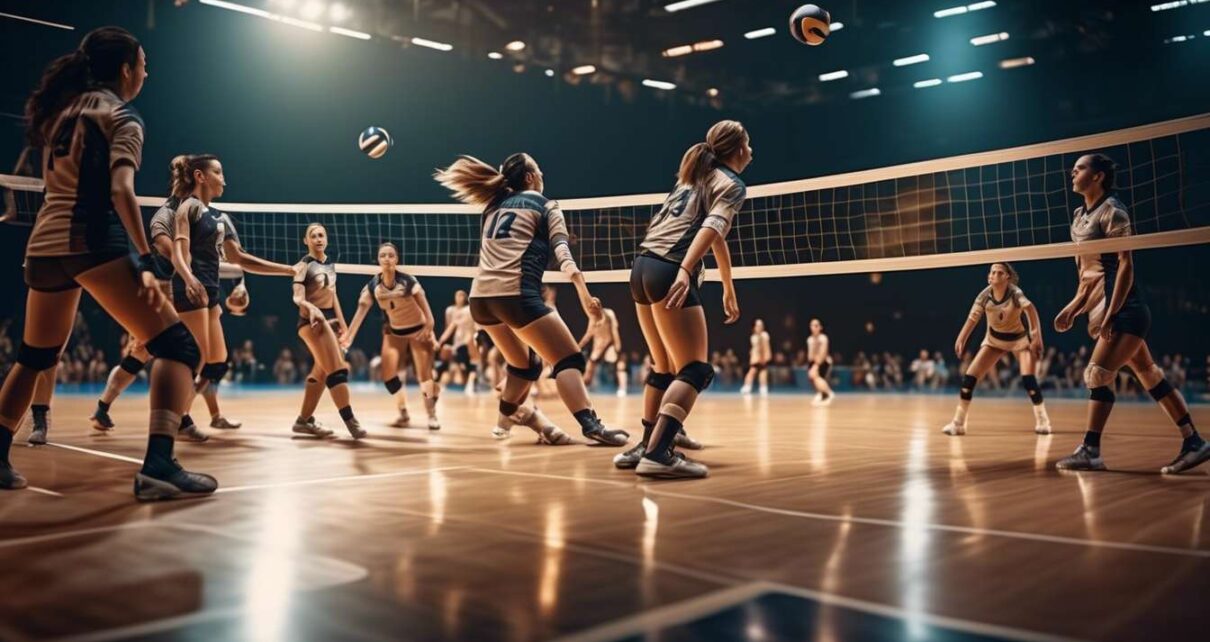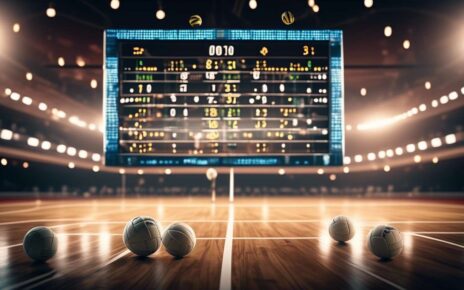Volleyball enthusiasts and analysts are always on the lookout for ways to deepen their understanding of the game. In the fast-paced world of volleyball, where split-second decisions can determine the outcome of a match, analyzing key factors is imperative.
Our collective passion drives us to explore the nuances that contribute to a team’s success on the court. By examining these elements, we aim to provide insights that coaches, players, and fans alike can utilize to enhance performance and strategic planning.
In this article, we will delve into the eight key factors that are crucial in volleyball match analysis:
-
Serve Reception: The foundation of a successful play, ensuring the ball is accurately passed to the setter.
-
Attack Efficiency: Measures the effectiveness of converting plays into points.
-
Blocking: Evaluates how well a team can prevent the opponent’s attack from crossing the net.
-
Defense: Assesses the ability to dig and keep the ball in play after an opponent’s attack.
-
Serving: Focuses on how serves can be used to disrupt the opponent’s play.
-
Setter Performance: The setter’s ability to distribute the ball effectively to different attackers.
-
Team Cohesion: Examines how well players communicate and coordinate on the court.
-
Mental Toughness: The team’s resilience under pressure and ability to maintain focus.
By sharing our findings, we hope to foster a greater appreciation for the intricacies of volleyball and inspire others to engage in their own analytical pursuits.
Together, let’s uncover what makes a winning strategy in volleyball.
Serve Reception
Successful serve reception is crucial as it determines our team’s ability to transition into a strong offensive play. When we nail those receptions, our chances of executing precise sets and powerful attacks increase significantly. It’s a team effort where everyone knows their role, creating a sense of unity that’s vital for our success. In those moments, we feel connected and unstoppable, ready to conquer whatever comes our way.
Impact on Attack Efficiency:
- A good reception allows our setter to deliver the ball precisely where it’s needed.
- This enables our hitters to quickly execute their attacks.
- Efficiency in attack keeps our opponents guessing and on the defensive, giving us the upper hand.
Benefits of Consistent Serve Reception:
-
Strengthens Blocking Strategy:
- Our blockers can better anticipate the opposing team’s attacks.
- They can position themselves strategically to counter the opponents’ moves.
-
Forms the Backbone of Victorious Gameplay:
- Seamless serve reception.
- Effective attack execution.
- Solid blocking.
Together, these elements create a cohesive and formidable team performance.
Attack Efficiency
Executing sharp and well-coordinated attacks is key to keeping our opponents on their toes and maintaining our competitive edge.
To achieve high attack efficiency, we must first excel in serve reception. A strong serve reception sets the stage for a powerful offensive play, allowing us to transition smoothly into our attacks. By communicating effectively and positioning ourselves strategically, we can consistently deliver precise passes to our setters.
Once the ball is in the setter’s hands, it’s crucial to make quick decisions that capitalize on the opponent’s weaknesses. Our aim is to distribute the ball in a way that keeps their blockers guessing, ultimately creating gaps in their defense.
By fostering a culture of teamwork and trust, we can execute these strategies seamlessly, ensuring each spike has the maximum impact.
Let’s remember that:
- Our collective effort in improving attack efficiency not only enhances our game.
- It also strengthens our bond as a team.
- Together, we become an unstoppable force on the court.
Blocking
To dominate at the net, we must perfect our timing and coordination in blocking. It’s a collective effort, demanding seamless communication and trust among us. Blocking isn’t just about stopping the ball; it’s about reading the opponent’s attack and anticipating their moves.
Key Elements of Successful Blocking:
-
Serve Reception:
- Sets the tone for positioning.
- Allows swift response to offensive threats.
-
Momentum Shift:
- A successful block can boost team morale.
- Shakes the opponent’s confidence.
-
Strategy Integration:
- Translate attack efficiency into blocking tactics.
- Analyze opponent’s tendencies.
- Predict attack routes for optimal block placement.
Together, we build a wall that not only defends but also intimidates. Each block is a statement of our unity and determination. We embrace the challenge, knowing that every touch at the net is an opportunity to take control of the game and create a sense of belonging within our team.
Defense
In defense, we focus on quick reflexes and strategic positioning to anticipate and counter the opponent’s attacks efficiently. Our success hinges on our ability to work as a cohesive unit, creating a sense of unity and trust.
Serve reception is our first line of defense, laying the groundwork for a successful counterattack. By honing our skills in this area, we ensure that we’re ready to set up an effective offense right from the start.
Blocking plays a crucial role in our defensive strategy, acting as the first barrier against our opponents’ attacks. It requires us to:
- Read the game
- Communicate effectively
- React instantly to the movements of the opposing team
By doing so, we enhance our attack efficiency, giving us the upper hand in rallies.
Together, we commit to supporting each other, moving fluidly as a single entity on the court. Defense isn’t just about stopping the ball; it’s about:
- Creating a fortress
- Making every play count
- Fostering a sense of belonging within our team.
Serving
Mastering serves is essential as it sets the tone for the match and can disrupt the opponent’s formation. When we serve with precision, we force our opponents into challenging Serve Reception, increasing the likelihood of errors.
A strong serve isn’t just about power; it’s about strategy and placement, making it difficult for the opposing team to execute a smooth attack.
By targeting specific zones and players, we can exploit weaknesses and reduce their Attack Efficiency. A well-placed serve can lead to a poor pass, disrupting their setup and giving us the chance to organize a solid defense. This opens opportunities for our blockers to anticipate and react effectively, positioning themselves to shut down potential attacks.
Our serving strategy unites us as a team, as we communicate and adjust based on real-time observations. It’s not just an individual effort but a collective one that strengthens our bond and enhances our overall performance on the court.
Together, we create pressure, seize control, and elevate our game.
Setter Performance
A setter’s performance is crucial in orchestrating our team’s offensive plays and maintaining a fluid game rhythm. We rely heavily on our setter to transform a solid serve reception into a seamless attack. Their ability to read the opposing blockers and make split-second decisions directly impacts our attack efficiency.
When our setter is on point, they create opportunities that allow our hitters to shine, increasing our chances of scoring.
Our connection as a team deepens when we trust our setter to distribute the ball effectively. A well-timed set can exploit weak spots in the opponent’s blocking, giving us the upper hand. It’s amazing how a single player can influence the game’s tempo and energy.
The setter’s role extends beyond just setting the ball; they’re the heartbeat of our play. By mastering strategic serve receptions and enhancing attack efficiency, our setter aids in building a cohesive unit that thrives on precision and shared goals.
Team Cohesion
Our team’s success hinges on the strength of our cohesion, where trust and communication elevate our collective performance.
Serve Reception and Attack:
- When we’re in sync, our serve reception becomes seamless, allowing us to transition smoothly into attack.
- Everyone knows their role, and we anticipate each other’s moves, creating a rhythm that’s hard to break.
- This unity boosts our attack efficiency as we connect on pass after pass, setting up powerful spikes that opponents struggle to defend against.
Blocking:
- Blocking also benefits from our togetherness.
- When we communicate effectively, our blockers can better position themselves, reading the opponent’s play and reacting in unison.
- This results in a formidable wall that frustrates even the most skilled attackers.
Shared Purpose and Team Environment:
- Our shared sense of purpose and understanding transforms individual efforts into a cohesive force.
- We draw strength from each other, creating an environment where every player feels valued and integral to our success.
Together, we’re more than a team; we’re a family.
Mental Toughness
Mental toughness is our backbone, enabling us to stay focused and resilient under pressure. When we’re on the court, every moment demands our full presence. Whether it’s nailing that perfect serve reception or boosting our attack efficiency, we understand that our mental game is just as crucial as our physical skills.
We’ve all felt those high-pressure moments where the game hinges on a single point. It’s our collective mental strength that carries us through.
In the heat of competition:
- Blocking isn’t just about stopping the ball—it’s about overcoming our own doubts.
- We remind ourselves that every block, every serve reception, and every attack is an opportunity to excel.
This mindset applies not only individually but also as a united team.
Our mental toughness binds us together, fostering a sense of belonging and trust. We support each other, knowing that our shared resilience is what makes us formidable opponents and a tight-knit volleyball family.
Together, we rise, every game, every set.
What role does player height play in overall volleyball match performance?
Player Height and Volleyball Performance
Player height significantly impacts overall volleyball match performance. Our team believes that taller players have an advantage in several key areas:
- Blocking at the Net: Taller players can effectively block opponents, making it difficult for them to score.
- Spiking Over the Block: With greater reach, taller players can spike the ball over opponents, increasing scoring opportunities.
- Court Coverage: They cover more area and can reach higher, posing challenges for opponents trying to score points.
However, height is just one factor among many that contribute to a player’s performance on the volleyball court. Other factors, such as skill level, agility, and teamwork, also play crucial roles in a player’s overall effectiveness.
How do environmental factors, like temperature and altitude, affect a volleyball match?
When we play volleyball, environmental factors, such as temperature and altitude, can deeply influence the match dynamics.
High temperatures may impact our:
- Endurance
- Hydration levels
These effects can significantly affect our performance on the court.
Similarly, playing at high altitudes can lead to:
- Decreased oxygen levels
- Increased fatigue
This can affect our ability to execute plays effectively.
It’s crucial to adapt our strategies and preparation to these environmental conditions for optimal performance.
What is the impact of player substitutions on team dynamics during a match?
Player substitutions play a crucial role in shaping our team dynamics during a match.
They inject fresh energy onto the court, providing new perspectives and strengths. Each substitution can alter the flow of the game, influencing our momentum and strategy.
By strategically rotating players based on their skills and the game situation, we can:
- Maintain a cohesive team dynamic.
- Adapt to changing game conditions.
- Enhance overall performance on the court.
In summary, thoughtful player substitutions are key to a successful match strategy.
Conclusion
In conclusion, analyzing key factors in volleyball matches is crucial for improving team performance. By focusing on the following aspects, teams can identify strengths and weaknesses to work on:
- Serve reception
- Attack efficiency
- Blocking
- Defense
- Serving
- Setter performance
- Team cohesion
- Mental toughness
Utilizing match analysis allows for targeted training and strategic adjustments, leading to overall growth and success on the court.
Remember, continuous evaluation and improvement in these areas will ultimately contribute to a stronger and more competitive team.




